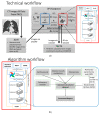AI-Supported Comprehensive Detection and Quantification of Biomarkers of Subclinical Widespread Diseases at Chest CT for Preventive Medicine
- PMID: 36360507
- PMCID: PMC9690402
- DOI: 10.3390/healthcare10112166
AI-Supported Comprehensive Detection and Quantification of Biomarkers of Subclinical Widespread Diseases at Chest CT for Preventive Medicine
Abstract
Automated image analysis plays an increasing role in radiology in detecting and quantifying image features outside of the perception of human eyes. Common AI-based approaches address a single medical problem, although patients often present with multiple interacting, frequently subclinical medical conditions. A holistic imaging diagnostics tool based on artificial intelligence (AI) has the potential of providing an overview of multi-system comorbidities within a single workflow. An interdisciplinary, multicentric team of medical experts and computer scientists designed a pipeline, comprising AI-based tools for the automated detection, quantification and characterization of the most common pulmonary, metabolic, cardiovascular and musculoskeletal comorbidities in chest computed tomography (CT). To provide a comprehensive evaluation of each patient, a multidimensional workflow was established with algorithms operating synchronously on a decentralized Joined Imaging Platform (JIP). The results of each patient are transferred to a dedicated database and summarized as a structured report with reference to available reference values and annotated sample images of detected pathologies. Hence, this tool allows for the comprehensive, large-scale analysis of imaging-biomarkers of comorbidities in chest CT, first in science and then in clinical routine. Moreover, this tool accommodates the quantitative analysis and classification of each pathology, providing integral diagnostic and prognostic value, and subsequently leading to improved preventive patient care and further possibilities for future studies.
Keywords: CT imaging postprocessing; artificial intelligence; comorbidities; computer assisted image analysis; machine learning; medical computing; medical image processing; preventive medicine; radiomics.
Conflict of interest statement
Stephan Skornitzke and Viktoria Palm have ownership interests in investment funds containing stock of healthcare companies. Fabian Rengier is, at the time of submission, employee of Bayer Vital GmbH, Germany, but the work presented herein dates to his previous employment at Heidelberg University Hospital. Otherwise, the authors of this manuscript declare no conflict of interest. The funders had no role in the design of the study; in the collection, analyses, or interpretation of data; in the writing of the manuscript; or in the decision to publish the results.
Figures



Similar articles
-
Comparison of Chest Radiograph Interpretations by Artificial Intelligence Algorithm vs Radiology Residents.JAMA Netw Open. 2020 Oct 1;3(10):e2022779. doi: 10.1001/jamanetworkopen.2020.22779. JAMA Netw Open. 2020. PMID: 33034642 Free PMC article.
-
A novel reporting workflow for automated integration of artificial intelligence results into structured radiology reports.Insights Imaging. 2024 Mar 19;15(1):80. doi: 10.1186/s13244-024-01660-5. Insights Imaging. 2024. PMID: 38502298 Free PMC article.
-
A computational pipeline for quantification of pulmonary infections in small animal models using serial PET-CT imaging.EJNMMI Res. 2013 Jul 23;3(1):55. doi: 10.1186/2191-219X-3-55. EJNMMI Res. 2013. PMID: 23879987 Free PMC article.
-
Machine intelligence in non-invasive endocrine cancer diagnostics.Nat Rev Endocrinol. 2022 Feb;18(2):81-95. doi: 10.1038/s41574-021-00543-9. Epub 2021 Nov 9. Nat Rev Endocrinol. 2022. PMID: 34754064 Free PMC article. Review.
-
AI-Based Detection, Classification and Prediction/Prognosis in Medical Imaging:: Towards Radiophenomics.PET Clin. 2022 Jan;17(1):183-212. doi: 10.1016/j.cpet.2021.09.010. PET Clin. 2022. PMID: 34809866 Review.
Cited by
-
[Patient-centered, value-based management of incidental findings in radiology].Radiologie (Heidelb). 2023 Sep;63(9):657-664. doi: 10.1007/s00117-023-01200-0. Epub 2023 Aug 11. Radiologie (Heidelb). 2023. PMID: 37566128 Review. German.
-
Midregional Proatrial Natriuretic Peptide (MRproANP) is associated with vertebral fractures and low bone density in patients with chronic obstructive pulmonary disease (COPD).Respir Res. 2024 Jul 13;25(1):274. doi: 10.1186/s12931-024-02902-2. Respir Res. 2024. PMID: 39003487 Free PMC article.
-
A vision attention driven Language framework for medical report generation.Sci Rep. 2025 Mar 28;15(1):10704. doi: 10.1038/s41598-025-95666-8. Sci Rep. 2025. PMID: 40155699 Free PMC article.
-
Unveiling the Influence of AI on Advancements in Respiratory Care: Narrative Review.Interact J Med Res. 2024 Dec 20;13:e57271. doi: 10.2196/57271. Interact J Med Res. 2024. PMID: 39705080 Free PMC article. Review.
References
-
- Kopf S., Groener J.B., Kender Z., Fleming T., Brune M., Riedinger C., Volk N., Herpel E., Pesta D., Szendrödi J., et al. Breathlessness and Restrictive Lung Disease: An Important Diabetes-Related Feature in Patients with Type 2 Diabetes. Respir. Int. Rev. Thorac. Dis. 2018;96:29–40. doi: 10.1159/000488909. - DOI - PubMed
Grants and funding
LinkOut - more resources
Full Text Sources

